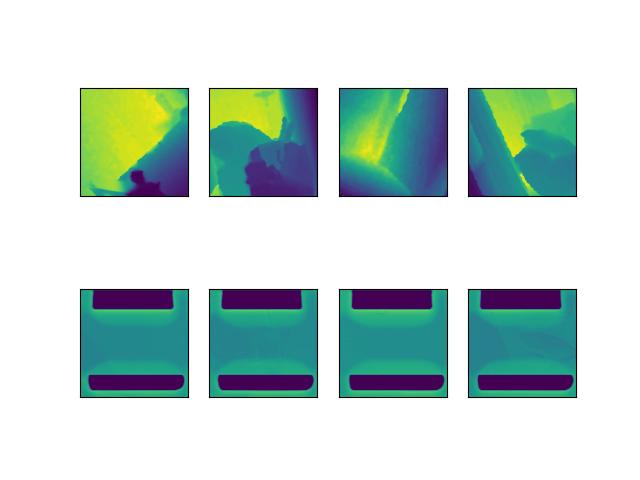Top row is ground truth and bottom row is result. I don’t know why all of them are same. Some results where slightly different in some iteration. What should I look out for?

I had successful result from denseNet so I wanted to try resnet and skip connection methods. This is my architecture.
def weights_init(m):
# Initialize kernel weights with Gaussian distributions
if isinstance(m, nn.Conv2d):
n = m.kernel_size[0] * m.kernel_size[1] * m.out_channels
m.weight.data.normal_(0, math.sqrt(2. / n))
if m.bias is not None:
m.bias.data.zero_()
elif isinstance(m, nn.ConvTranspose2d):
n = m.kernel_size[0] * m.kernel_size[1] * m.in_channels
m.weight.data.normal_(0, math.sqrt(2. / n))
if m.bias is not None:
m.bias.data.zero_()
elif isinstance(m, nn.BatchNorm2d):
m.weight.data.fill_(1)
m.bias.data.zero_()
def conv(in_channels, out_channels, kernel_size):
padding = (kernel_size-1) // 2
assert 2*padding == kernel_size-1, "parameters incorrect. kernel={}, padding={}".format(kernel_size, padding)
return nn.Sequential(
nn.Conv2d(in_channels,out_channels,kernel_size,stride=1,padding=padding,bias=False),
nn.BatchNorm2d(out_channels),
nn.ReLU(inplace=True),
)
def pointwise(in_channels, out_channels):
return nn.Sequential(
nn.Conv2d(in_channels,out_channels,1,1,0,bias=False),
nn.BatchNorm2d(out_channels),
nn.ReLU(inplace=True),
)
class ResNetSkipAdd(nn.Module):
def __init__(self, layers, output_size, in_channels=3, pretrained=True):
if layers not in [18, 34, 50, 101, 152]:
raise RuntimeError('Only 18, 34, 50, 101, and 152 layer model are defined for ResNet. Got {}'.format(layers))
super(ResNetSkipAdd, self).__init__()
self.output_size = output_size
pretrained_model = models.__dict__['resnet{}'.format(layers)](pretrained=pretrained)
if not pretrained:
pretrained_model.apply(weights_init)
if in_channels == 3:
self.conv1 = pretrained_model._modules['conv1']
self.bn1 = pretrained_model._modules['bn1']
else:
self.conv1 = nn.Conv2d(in_channels, 64, kernel_size=7, stride=2, padding=3, bias=False)
self.bn1 = nn.BatchNorm2d(64)
weights_init(self.conv1)
weights_init(self.bn1)
self.relu = pretrained_model._modules['relu']
self.maxpool = pretrained_model._modules['maxpool']
self.layer1 = pretrained_model._modules['layer1']
self.layer2 = pretrained_model._modules['layer2']
self.layer3 = pretrained_model._modules['layer3']
self.layer4 = pretrained_model._modules['layer4']
# clear memory
del pretrained_model
# define number of intermediate channels
if layers <= 34:
num_channels = 512
elif layers >= 50:
num_channels = 2048
self.conv2 = nn.Conv2d(num_channels, 1024, 1)
weights_init(self.conv2)
kernel_size = 5
self.decode_conv1 = conv(1024, 1024, kernel_size)
self.decode_conv2 = conv(1024, 512, kernel_size)
self.decode_conv3 = conv(512, 256, kernel_size)
self.decode_conv4 = conv(256, 128, kernel_size)
self.decode_conv4b = conv(128, 64, kernel_size)
self.decode_conv5 = conv(64, 32, kernel_size)
self.decode_conv6 = pointwise(32, 1)
self.upSample = nn.Upsample(scale_factor=2, mode='nearest')
weights_init(self.decode_conv1)
weights_init(self.decode_conv2)
weights_init(self.decode_conv3)
weights_init(self.decode_conv4)
weights_init(self.decode_conv5)
weights_init(self.decode_conv6)
def forward(self, x):
# resnet
x = self.conv1(x)
x = self.bn1(x)
x1 = self.relu(x)
#print("x1", x1.size())
x2 = self.maxpool(x1)
#print("x2", x2.size())
x3 = self.layer1(x2)
#print("x3", x3.size())
x4 = self.layer2(x3)
#print("x4", x4.size())
x5 = self.layer3(x4)
#print("x5", x5.size())
x6 = self.layer4(x5)
#print("x6", x6.size())
x7 = self.conv2(x6)
#print("x7", x7.size())
# decoder
y10 = self.decode_conv1(x7)
#print("y10", y10.size())
y10 = self.upSample(y10)
y9 = F.interpolate(y10 + x5, scale_factor=2, mode='nearest')
#print("y9", y9.size())
y8 = self.decode_conv2(y9)
#print("y8", y8.size())
y7 = F.interpolate(y8 + x4, scale_factor=2, mode='nearest')
# print("y7", y7.size())
y6 = self.decode_conv3(y7)
#print("y6", y6.size())
y5 = F.interpolate(y6 + x3, scale_factor=2, mode='nearest')
#print("y5", y5.size())
y4 = self.decode_conv4(y5)
y4 = self.decode_conv4b(y4)
#print("y4", y4.size())
y3 = F.interpolate(y4 + x1, scale_factor=2, mode='nearest')
# print("y3", y3.size())
y2 = self.decode_conv5(y3)
# print("y2", y2.size())
y1 = F.interpolate(y2, scale_factor=1, mode='nearest')
# print("y1", y1.size())
y = self.decode_conv6(y1)
return y